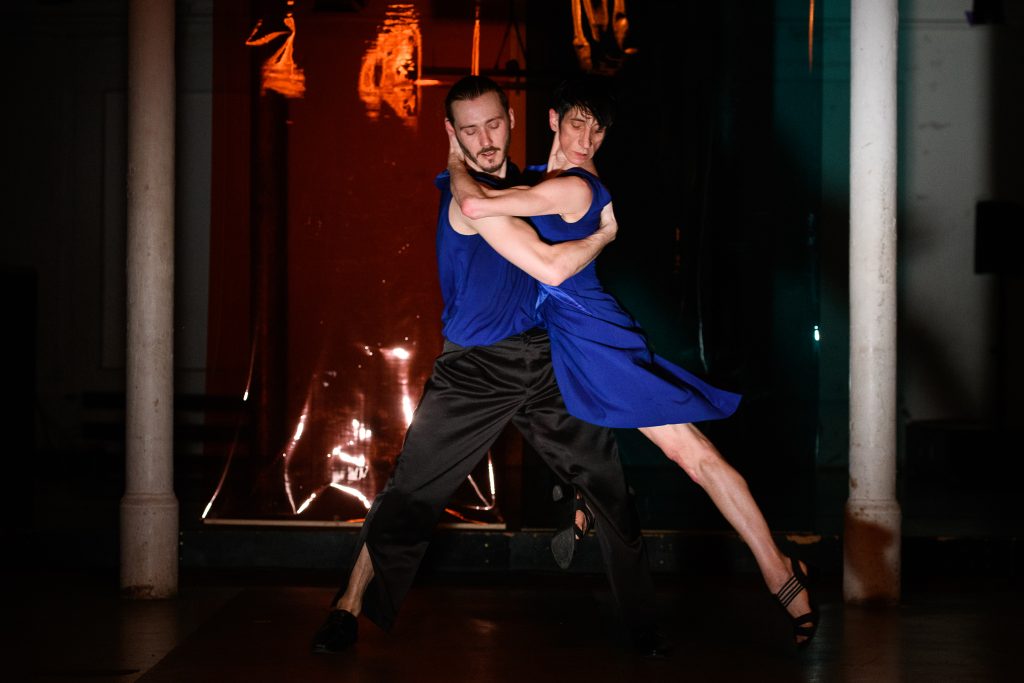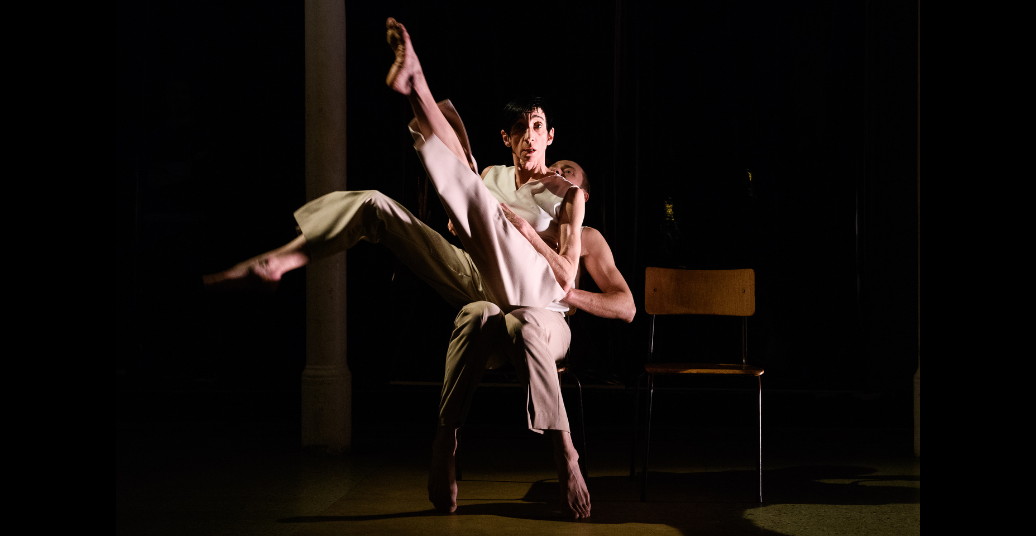On the occasion of the 20th anniversary of opening their Kreuzberg studio, laborgras (Renate Graziadei and Arthur Stäldi) showed “Er… Sie… und andere Geschichten” from 2 – 6 June 2022. In conversation, laborgras shared both a deeper insight into this work and a longer view of their decades as a collective.
Renate Graziadei and Arthur Stäldi formed laborgras in 1994 as a collective of two who regularly collaborate with other artists. I was drawn to talk with the collective about their long-term collaboration. I was curious about how the work develops over a timeline that spans decades, particularly when the approach is a research-based one, when the artists view dance as ‘an approach and an experiment, […] research, action and testing in equal measure.’ Over coffee, the week after they wrapped up their 20th birthday party for laborgras’s studio space in Kreuzberg, Graziadei and Stäldi gave me a glimpse into a few of the stops along their timeline past, present, and future, as well as some of the ‘other stories’ that feed them as an artistic duo.
Graziadei and Stäldi opened their Kreuzberg studio in 2002 with “Melting Point”, in which three dancers moving in different spaces, who were unable to see one another, were brought together using video cameras into a single virtual space. In celebration of two decades on Paul-Lincke-Ufer, however, they chose to restage their 2019 production “Er… Sie… und andere Geschichten” which emphasises the materiality of the space. With two dancers (Graziadei and Sergey Zhukov), 13 choreographies, each the length of a single song, and a roaming use of its surroundings that invites or requires the audience to change locations between each choreography, “Er… Sie… und andere Geschichten”(He … She … and Other Stories) has an upbeat and intimate feel. Stäldi, credited as dramaturg, told me they conceived the performance as a dance LP. This was palpable. As with a good album, I felt as though I had developed an intimate relationship with the dancer-choreographers by the time it was over, although they inhabited many stories and many characters. And like a good album, each track left me (pleasantly) wanting more.
When I asked what the ‘other stories’ referred to in the title were, Graziadei replied without skipping a beat, “The 13 pieces.” Then, after a breath: “Or the stories people make up as they watch.” One audience member told Stäldi that watching the show had given them the feeling that they were entering a different world every time they blinked — now science fiction, now a romance novel, now an animal world, now a world steeped in just one overwhelming emotion.

Photo: “Er… Sie… und andere Geschichten” by laborgras ©Phil Dera
My experience was similar, and I think this effect is tied to a dramaturgy that conceives of each episode as its own, standalone piece. The artists tried explicitly, according to Stäldi and Graziadei, not to carry material from one piece into the next — the stories are strictly episodic rather than tracing a single narrative arc. You could even snap the performance apart and rearrange it and it would still work. In some performance contexts, laborgras has put up a smaller selection of the choreographies, just three or four. Stäldi told me that this particular dramaturgy came out of their experiences in the USA, where they were struck by the fact that a dance piece could “last as long as it lasts.” This was, he said, in contrast to Europe, where the evening-length format took precedence — choreographers would always make a performance to fill an entire evening. In the USA, if it needed to be 15 minutes, however, that’s what it would be. Following their interest in working in unfamiliar ways, laborgras began to experiment with this approach.
This draw to experimentation and embodied research fits within a larger arc of laborgras’s work, of which “Er… Sie… und andere Geschichten” is just a small part. As we talked, I noticed how often they both spoke of emotion, of the way it was central to creating the distinct feel of each episode. So it didn’t surprise me to hear that emotions were a major impetus for laborgras’s long-term working cycle “Early Music and Contemporary Dance”, begun in 2020, in which they create a marriage of contemporary movement with works by composers such as Bach, Händel, and Corelli. What interested them in classical music, they said, started from the strong emotions it brought into the room. Though most of the music was written for dance in the first place, they begin with the emotion as their material, rather than what they know of the period in which the music was composed. In “Das Fest” (turned into a ‘danceconcertfilm’ during the pandemic, but planned for a stage premiere this fall) and “sinnestaumel” (which premiered in November 2021), they work with live musicians, the existing musical compositions, and a contemporary dance vocabulary to research what the forms can mutually highlight in and upon one another. Graziadei told me she wanted to explore making people “happily sad” with some of this work, and teased Stäldi for being not so interested in sadness.
I told them I liked that happy-sad feeling.
“Oh, so you’re a romantic,” Stäldi said, and asked me if I’d liked the piece from “Er… Sie… und andere Geschichten” set to the Kronos Quartet. “That’s up your alley.”
“You think that one is sad?” Graziadei asked him. He smiled and shrugged. I thought about the ‘other stories’ that make up such a collaborative relationship, as well — that when it works, and works for so long, it isn’t necessarily because the collective has merged into a unit. Collaborative work thrives from the presence of all those ‘other stories’, the ones the artists bring to the work and the ones they come up with about the work they’re making.
“Er… Sie… und andere Geschichten” by laborgras, which premiered on February 2019, was shown again from 2 to 6 June 2022 to kick off their 25th anniversary season at Studio laborgras, Kreuzberg.




